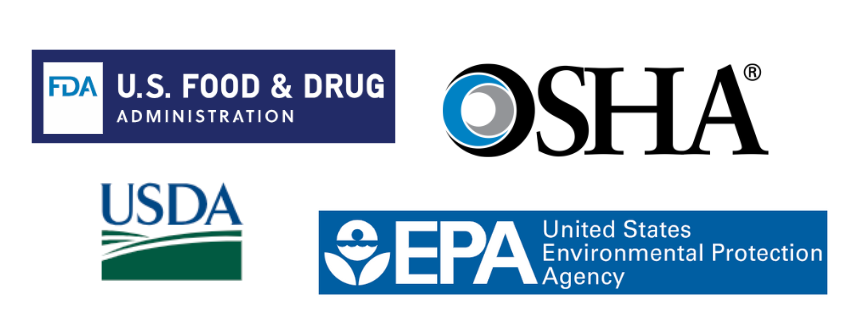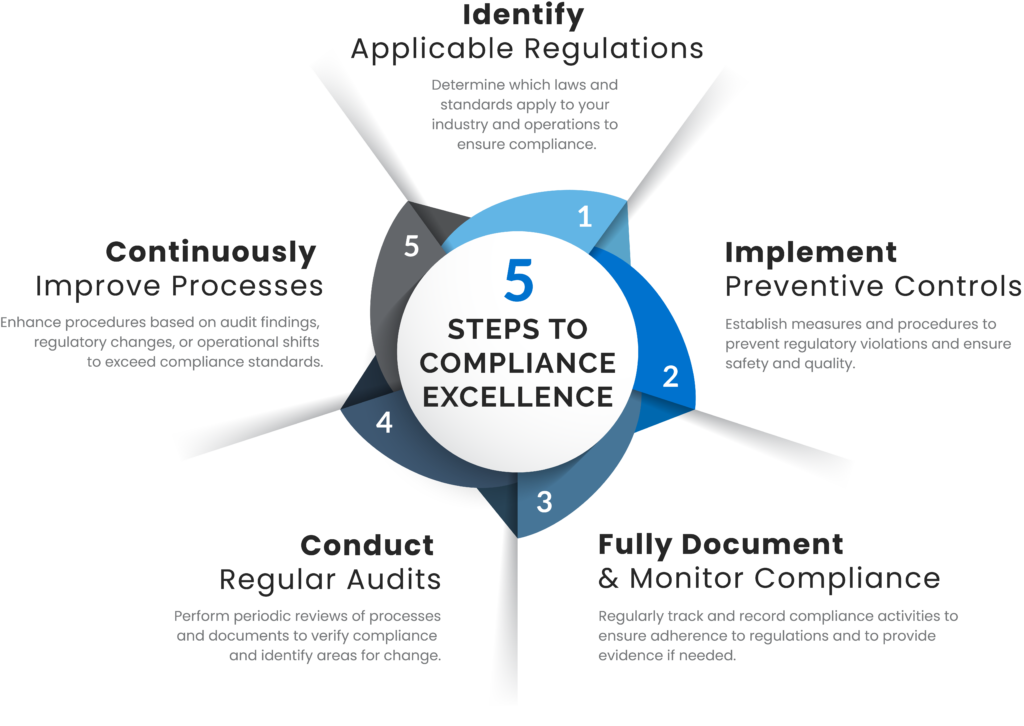Compliance Excellence: Navigating Manufacturing Regulations
In today’s manufacturing world, staying compliant with the ever-changing regulatory landscape is a crucial challenge. Regulatory bodies like the FDA, USDA, EPA, OSHA, and ISO continually update their standards to address safety, quality, and environmental concerns. These updates impact not only compliance but also how businesses operate, particularly in industries like food processing, chemicals, agriculture, and packaging. For manufacturers, navigating manufacturing regulations is critical—not just to avoid fines, but to maintain efficiency and ensure the trust of customers.
Staying on top of these regulations doesn’t have to be daunting. By leveraging the right technologies, manufacturers can streamline compliance processes, enhance operational efficiency, and turn these changes into competitive advantages. Let’s break down the key regulatory agencies shaping the industry, explore recent changes in their policies, and discuss how businesses in food and processing industries can adapt effectively.
The Complexity of Navigating Manufacturing Regulations
Regulations are designed to ensure consumer safety, protect the environment, and guarantee the quality of products. However, navigating these rules can be particularly challenging in industries with overlapping regulations. The FDA sets stringent food safety standards to prevent contamination, while the USDA focuses on food transparency and sustainability. Meanwhile, the EPA tackles environmental impacts, particularly in industries that involve chemicals or high energy consumption, and OSHA ensures workplace safety standards are met. On a global scale, ISO standards help businesses maintain high-quality processes and environmentally friendly practices.

FDA: The Shift Toward Preventive Food Safety
For companies involved in food manufacturing, the Food and Drug Administration (FDA) plays a pivotal role in regulating safety and quality. The Food Safety Modernization Act (FSMA) shifted the FDA’s focus from reactive to preventive. Under FSMA, food manufacturers must implement comprehensive Hazard Analysis and Critical Control Points (HACCP) programs, aimed at preventing contamination before it happens.
The FDA also mandates detailed record-keeping, particularly for companies involved in the processing of perishable foods. In addition to regular inspections, the FDA conducts unannounced audits to ensure food safety practices are being followed. Non-compliance can lead to fines, recalls, or production shutdowns, as seen in the 2019 peanut butter contamination case, which resulted in a nationwide recall. Manufacturers must now track and document every step of their processes, which can be streamlined using digital record-keeping systems.
USDA: Tightening Controls on Food Safety and Sustainability
The United States Department of Agriculture (USDA) regulates agricultural practices and food production, with growing attention on transparency and sustainability. Recently, the USDA proposed a new policy aimed at reducing Salmonella contamination in raw poultry products, as detailed in this announcement. This new rule could place a significant strain on the poultry industry, requiring manufacturers to update their food safety protocols, processing equipment, and even supplier management practices to comply with the stricter controls.
Additionally, USDA regulations around Country of Origin Labeling (COOL) and organic certifications are also tightening. These rules require food manufacturers to clearly identify the sources of their products and adhere to environmentally sustainable farming practices. Non-compliance can lead to certification revocations or penalties, which could be disastrous for a company’s market reputation. The USDA’s focus on organic and non-GMO labeling has pushed manufacturers to improve transparency across their supply chains.
EPA: Addressing Environmental Sustainability and Compliance
For companies working with chemicals or those that have significant environmental impacts, the Environmental Protection Agency (EPA) imposes strict regulations on emissions, waste disposal, and chemical use. The Toxic Substances Control Act (TSCA) governs the use of chemicals in production, and recent updates to the Clean Air Actand Clean Water Act have introduced more stringent controls on emissions and waste management.
One of the key recent changes is the EPA’s increased emphasis on green chemistry. This movement encourages manufacturers to use safer, more sustainable chemicals in production processes, pushing industries to adopt cleaner technologies. The EPA also requires businesses to report on chemical usage and emissions levels, and non-compliance can lead to significant fines and legal penalties. A chemical processing company, for instance, was recently fined for failing to adhere to TSCA guidelines, highlighting the importance of adopting environmentally sustainable practices.
In response to these regulations, companies are increasingly adopting IoT (Internet of Things) technologies to monitor emissions and chemical usage in real time, helping them stay compliant.
OSHA: Worker Safety in High-Risk Environments
The Occupational Safety and Health Administration (OSHA) is responsible for ensuring workplace safety, particularly in high-risk environments like food processing and chemical manufacturing. OSHA’s recent updates to its Hazard Communication Standard (HCS), which aligns with the Globally Harmonized System (GHS), require stricter labeling and safety protocols for hazardous chemicals. These rules are particularly relevant for manufacturers working with dangerous substances or machinery.
For example, a food processing plant recently faced hefty fines after a worker was injured due to inadequate safety protocols. OSHA’s regulations ensure that manufacturers provide the right training and equipment to reduce workplace accidents, and non-compliance can result in both financial and legal consequences. Digital safety management systems can help streamline compliance by tracking training records, safety incidents, and worker certifications.
Adapting to Regulatory Changes with Technology
Navigating manufacturing regulations requires more than just keeping track of changes; it demands a proactive approach to compliance. Digital solutions offer powerful tools for manufacturers to stay compliant and streamline operations. For instance, blockchain technology is becoming increasingly popular in the food industry to improve traceability and transparency, particularly with USDA’s country-of-origin labeling requirements and FDA’s preventive controls.
Additionally, quality management systems (QMS) integrated with IoT sensors can help manufacturers in the chemical and food sectors track emissions, monitor safety compliance, and maintain detailed records of production processes. These systems ensure compliance with standards set by both the EPA and OSHA, giving businesses real-time insights into their operations. In one real-world example, a food packaging manufacturer adopted an automated QMS to monitor compliance with both USDA labeling and OSHA worker safety standards, resulting in reduced errors and faster audits.
By implementing the right technology, businesses can not only stay ahead of regulatory changes but also improve efficiency, reduce costs, and ensure product safety.
Conclusion: Staying Ahead of the Compliance Curve

Regulatory compliance is no longer a set-it-and-forget-it task. With constantly evolving regulations from agencies like the FDA, USDA, EPA, and OSHA, manufacturers must be agile in adapting their processes and systems. Falling behind on compliance can lead to devastating consequences, from hefty fines to product recalls and even factory shutdowns. As regulations grow more complex, manufacturers that fail to adapt risk losing their competitive edge.
What would it mean for your business if you fell behind? Could your operations withstand a major compliance failure, or would the costs be too high? Staying ahead of these changes by embracing digital solutions could mean the difference between thriving and falling behind in an increasingly regulated industry.



